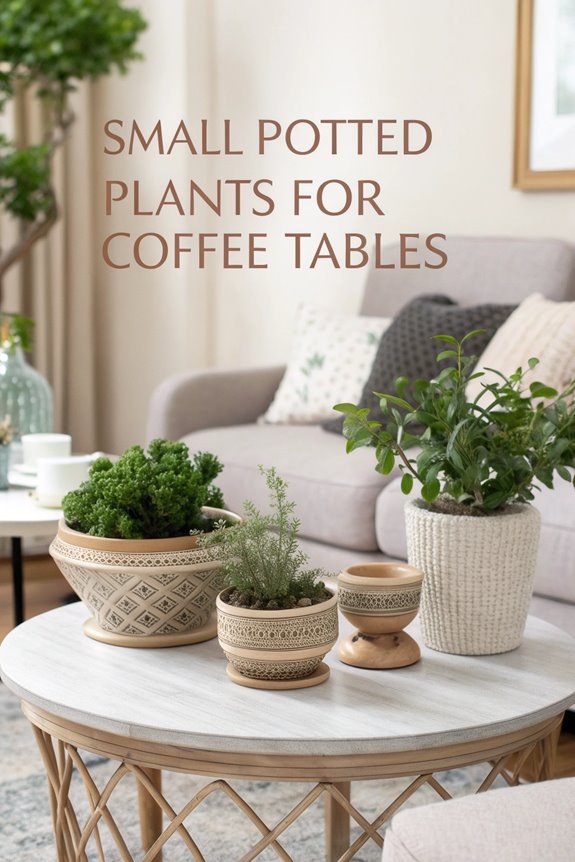16 Edging Plants for Defining Rock Garden Borders
The right edging plants can transform your rock garden with vibrant colors and charming textures along pathways. From low-maintenance varieties to pollinator-friendly options, there’s a plethora of choices available.
Are you ready to create the perfect border? Let’s dive into 16 fantastic plants that will enhance your garden landscape!
Creeping Thyme

When you think about adding some charm to your rock garden, don’t overlook creeping thyme! This delightful plant spreads like a cozy blanket, filling in gaps between stones with vibrant green.
Its tiny purple flowers pop up in summer, attracting bees and butterflies—talk about a garden party! Plus, it’s drought-tolerant, so you won’t need to play the watering game every day.
Just imagine walking through your garden, the fragrant leaves releasing a lovely aroma underfoot. You’ll love how it softens the hard edges of your rocks, turning your garden into a whimsical retreat.
Who knew charm could be so easy?
Sedum
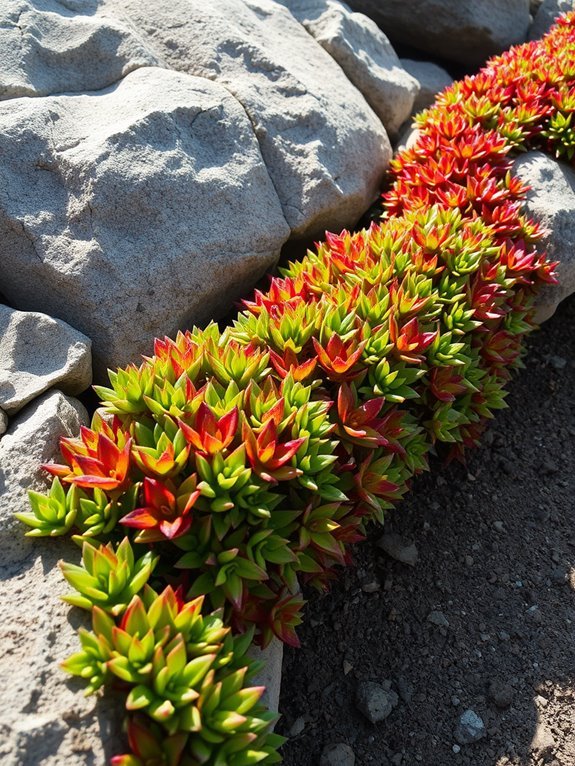
Sedum, often affectionately called stonecrop, is the superstar of low-maintenance landscaping!
This charming succulent thrives in rock gardens, bringing vibrant colors and textures without demanding much attention.
You’ll love how it effortlessly adds character to your borders. Plus, it’s got a knack for surviving dry spells—what a trooper!
Here’s why you should consider sedum for your garden:
- Diverse varieties for every taste
- Drought-resistant and low-maintenance
- Attracts pollinators like bees and butterflies
- Provides a lush ground cover
- Thrives in poor soil conditions
With sedum, you’ll have a stunning garden that practically takes care of itself!
Ajuga

Ajuga, or bugleweed as it’s sometimes called, is like the friendly neighbor of your rock garden—always ready to help out and brighten up the space!
This charming ground cover spreads quickly, creating a lush carpet of vibrant green foliage. With its stunning blue, purple, or white flowers, Ajuga adds a pop of color that even your most artistic friends will envy.
Plus, it’s tough and tolerates various soil types, making it perfect for those less-than-perfect spots. Just remember, it loves a bit of shade!
Japanese Spurge
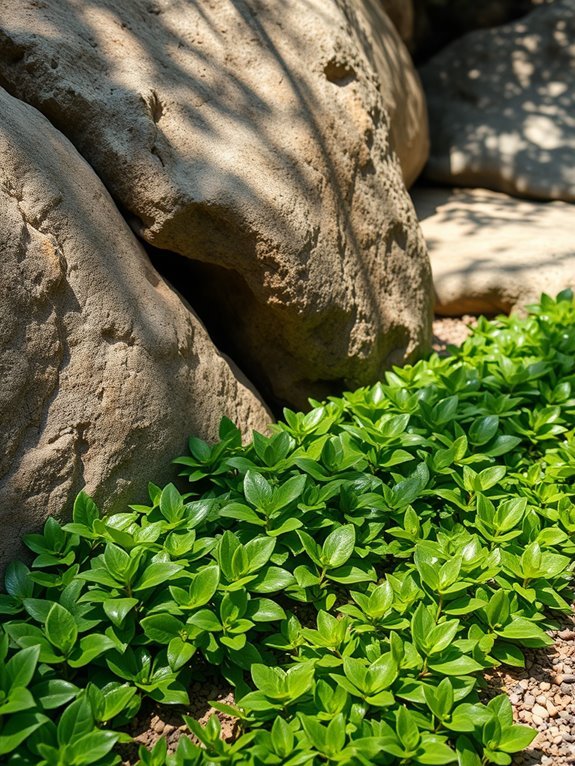
Imagine a lush green blanket hugging the rocky edges of your garden—this is what Japanese Spurge brings to the party! This delightful ground cover not only looks amazing but also thrives in shady spots, making it a top pick for your rock garden.
It’s low-maintenance and loves to spread its vibrant leaves, ensuring your borders stay defined and gorgeous.
Here’s why you’ll love Japanese Spurge:
- Adapts well to different soil types
- Tolerates shade like a champ
- Requires minimal watering
- Provides year-round greenery
- Acts as a natural weed barrier
With Japanese Spurge, your garden will be the talk of the neighborhood!
Catmint
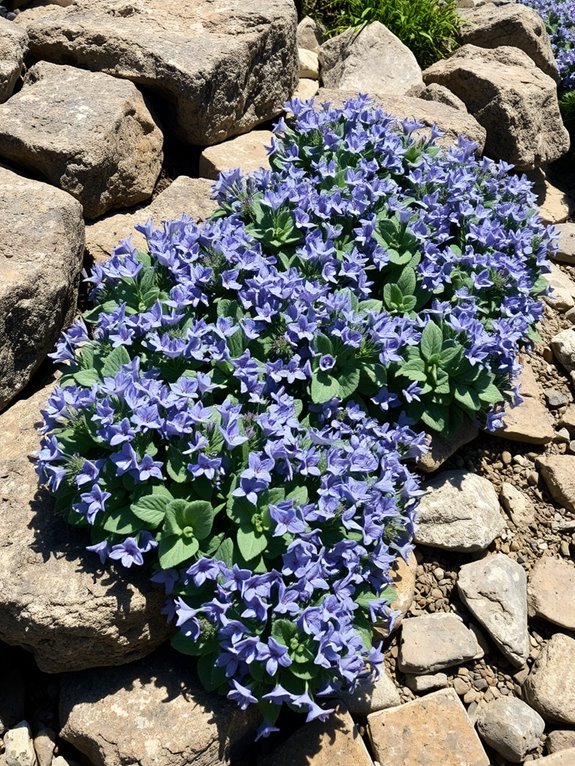
If you’re looking to add a splash of color and a delightful fragrance to your rock garden, catmint is the perfect choice!
This hardy perennial flaunts vibrant purple-blue flowers that bloom from late spring to early summer, attracting butterflies and bees like a magnet. Its silvery-green foliage adds texture, making it a gorgeous border plant.
Plus, catmint’s drought-resistant nature means you won’t be tied to constant watering—what a relief! Just a little pruning after flowering will keep it tidy.
Lavender

Lavender is like the superstar of the rock garden! Its vibrant purple blooms and soothing fragrance make it an excellent choice for edging.
You’ll love how it attracts bees and butterflies, adding a lively touch to your garden. Plus, it’s a hardy plant that thrives in poor soil—talk about low maintenance!
Here are some reasons to choose lavender for your rock garden borders:
- Beautiful, aromatic flowers
- Attracts pollinators
- Drought-tolerant and resilient
- Pairs well with other plants
- Great for culinary uses
Alpine Aster
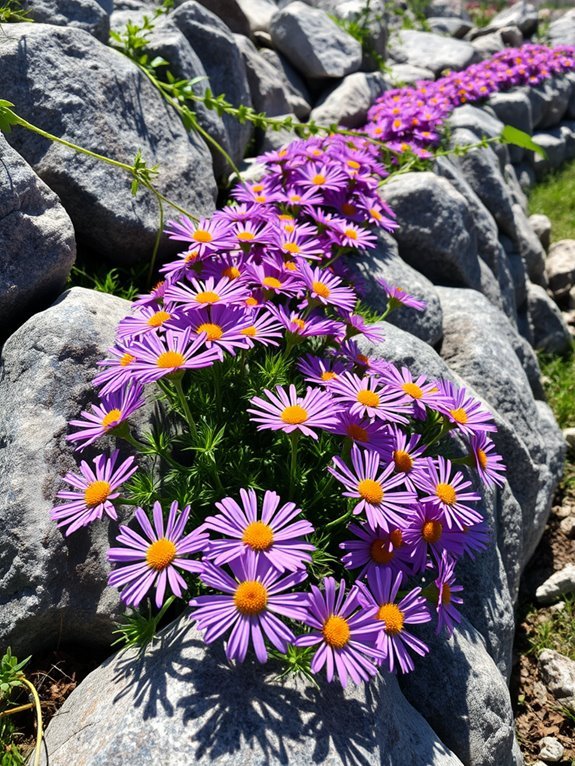
After enjoying the vibrant show of lavender, you’ll want to contemplate adding Alpine Aster to your rock garden borders.
This charming little plant bursts with cheerful blue and purple flowers, inviting smiles and compliments from visitors. It thrives in rocky, well-drained soil, making it a perfect companion for your rugged landscape.
Plus, it attracts butterflies, adding to the lively atmosphere. With its low-growing habit, Alpine Aster neatly edges your garden, creating a lovely contrast against boulders and gravel.
Just imagine those delightful blooms peeking through! Trust me, you won’t regret this colorful addition to your garden party.
Dianthus
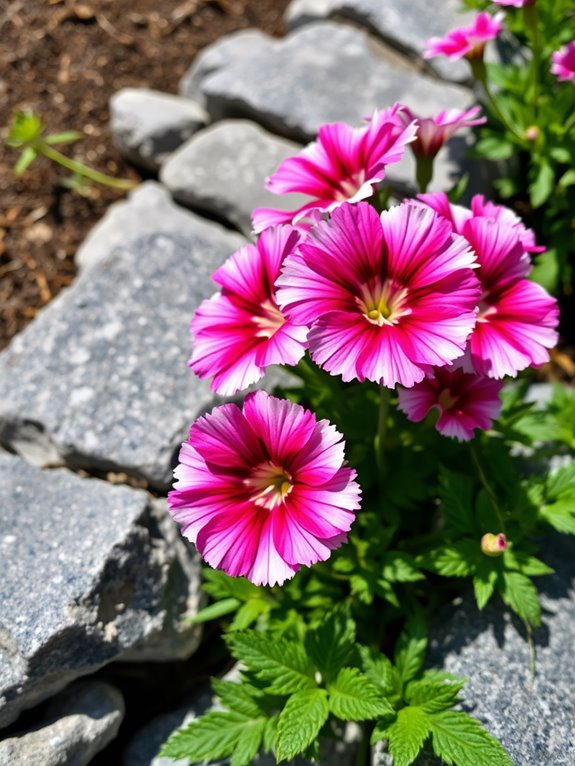
Dianthus, often called “pinks,” is like the cheerful friend of your rock garden, always ready to brighten the day with its stunning blooms.
These delightful flowers come in various colors, creating a vibrant display that’ll make you smile. Plus, they’re easy to care for!
Here are some reasons to love Dianthus:
- Fragrant blooms that attract butterflies
- Compact growth, perfect for edging
- Long-lasting flowers, keeping your garden pretty
- Drought-tolerant, perfect for those sunny spots
- Variety of colors, from soft pastels to bold hues
Stonecrop
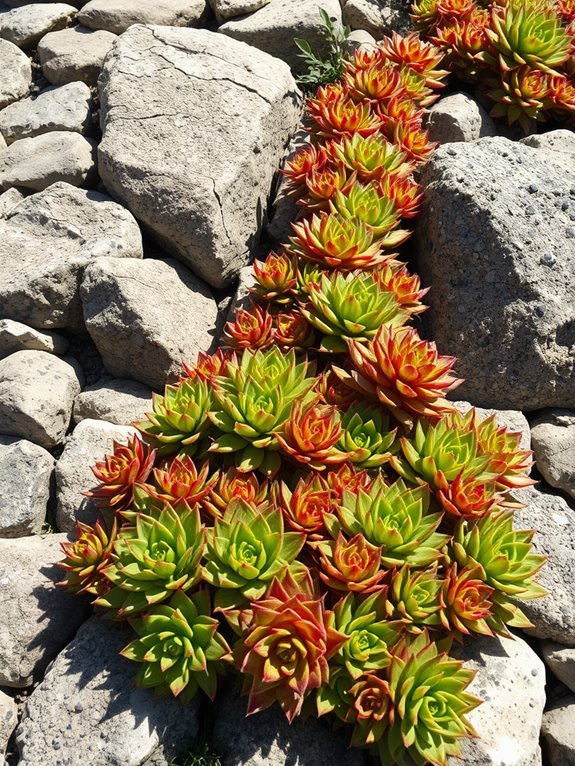
Picture a sunny day in your rock garden, where vibrant greens meet splashes of color—this is where Stonecrop shines!
This hardy succulent thrives in dry, rocky spots, making it a perfect companion for your garden’s edges. With its fleshy leaves and cheerful yellow or pink flowers, it adds a delightful charm.
Stonecrop’s low-growing habit means it won’t overshadow your taller plants; instead, it’ll weave around them like a colorful carpet. Plus, it’s drought-tolerant, so you won’t have to worry about constant watering.
Just imagine the smiles from visitors when they see this delightful beauty blooms in your garden!
Creeping Jenny

Creeping Jenny is like the cheerful friend of your rock garden, always ready to brighten things up! With its vibrant yellow-green leaves and stunning golden flowers, it adds a splash of color that’s hard to resist.
This low-growing perennial loves to spread out, making it a perfect edge for your borders.
Here are some reasons to adore Creeping Jenny:
- Thrives in both sun and shade
- Tolerates poor soil conditions
- Attracts pollinators like bees
- Provides excellent ground cover
- Offers stunning fall foliage
Hens and Chicks

If you’re looking to add a touch of whimsy to your rock garden, Hens and Chicks are the perfect choice!
These charming succulents, with their rosette-shaped leaves, aren’t only adorable but also incredibly low-maintenance. They thrive in rocky, well-drained soil, making them ideal for your garden. Plus, they can handle a little neglect, so you won’t have to babysit them constantly.
As they grow, they form delightful clusters that create a playful vibe. Just imagine their vibrant greens and pinks peeking out between your rocks!
You’ll love the personality they bring to your garden, making it truly unique.
Periwinkle

After adding the delightful clusters of Hens and Chicks to your rock garden, you might want to contemplate another fantastic option: Periwinkle.
This charming ground cover brings a splash of color and a touch of whimsy to your landscape. With its trailing vines and lovely purple flowers, it’s perfect for creating a soft border. Plus, it’s low-maintenance—who doesn’t love that?
Here are some great reasons to choose Periwinkle:
- Thrives in various soil types
- Attracts pollinators like bees and butterflies
- Provides year-round greenery
- Spreads easily, filling gaps
- Resilient to drought and shade
You’ll adore it!
Blue Fescue

Imagine a soft breeze rustling through a sea of vibrant, blue-green tufts—meet Blue Fescue, the stylish addition your rock garden has been waiting for!
This charming grass brings texture and color, creating a delightful contrast against rocky backdrops. With its compact form and easy-going nature, you won’t have to worry about it taking over your garden.
Plus, it’s drought-tolerant, so you can spend more time enjoying your space and less time watering!
Plant it in clusters for a stunning effect, and watch as it dances in the wind. Blue Fescue is the perfect partner for your garden dreams!
Heuchera
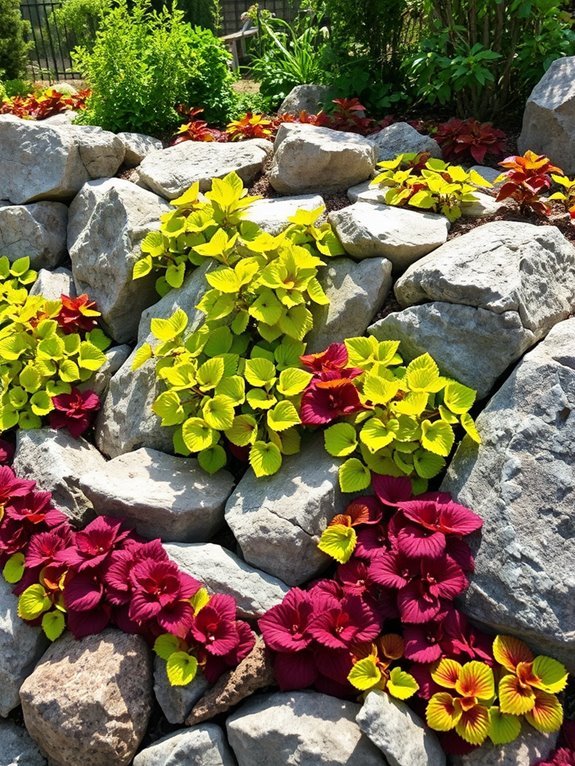
Heuchera, also known as coral bells, is like that vibrant friend who always brings the party to your rock garden! With its colorful foliage and delightful blooms, it’s a fantastic choice for edging.
You’ll love how it thrives in various conditions while adding a splash of personality. Plus, it attracts pollinators, which is a bonus!
Here are some reasons to contemplate Heuchera for your borders:
- Variety of colors: From deep purples to bright greens
- Low maintenance: It’s easy to care for
- Shade tolerant: Perfect for those tricky spots
- Drought resistant: Less worry about watering
- Long blooming season: Enjoy blooms from spring to fall!
Coreopsis

If you’re looking to add a cheerful touch to your rock garden, Coreopsis could be just the ticket!
These bright, daisy-like flowers burst with color, inviting smiles from anyone who strolls by. They thrive in sunny spots and don’t require much fuss, so you can spend more time enjoying your garden and less time maintaining it.
Plus, their compact size makes them perfect for edging along pathways or around rocks. Just imagine those sunny yellow blooms dancing in the breeze!
With Coreopsis, you’ll create a vibrant border that’s sure to catch the eye and lift your spirits. What’s not to love?
Ornamental Grasses
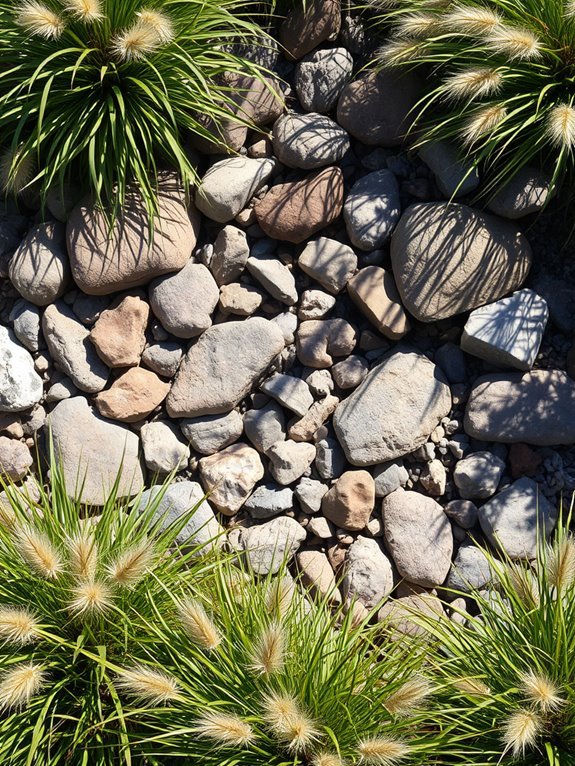
After brightening up your rock garden with the cheerful blooms of Coreopsis, why not add some movement and texture with ornamental grasses?
These beauties sway gracefully in the breeze, bringing life to your garden. Plus, they’re low-maintenance!
Here are some fantastic choices you might consider:
- Blue Fescue: A charming, compact option with blue-green foliage.
- Japanese Blood Grass: Offers striking red tips that add drama.
- Pampas Grass: Tall and fluffy, it makes a bold statement.
- Miscanthus: A versatile grass that brings height and softness.
- Feather Reed Grass: Perfect for creating a feathery border.
Get ready to dance with your garden!
Frequently Asked Questions
What Is the Best Time to Plant Edging Plants?
You should plant edging plants in early spring or fall. It’s when the soil’s warm enough for roots to establish but cool enough to reduce stress. Timing’s essential for healthy growth and vibrant borders.
How Often Should I Water My Edging Plants?
You should water your edging plants once a week, ensuring the soil stays moist but not soggy. During hot, dry spells, increase frequency to keep them healthy and thriving. Always check the soil’s moisture first.
Can Edging Plants Tolerate Drought Conditions?
Imagine a resilient warrior braving the desert sun. Edging plants, like this warrior, can indeed tolerate drought, especially if you choose drought-resistant varieties. Just guarantee you give them good soil and occasional care for best results.
How Do I Maintain the Health of My Edging Plants?
To maintain your edging plants’ health, guarantee they receive adequate water, provide proper nutrients, and check for pests regularly. Pruning and mulching can also help promote growth and protect against harsh conditions. Keep an eye on them!
Are There Any Pests That Commonly Affect Edging Plants?
Yes, several pests can affect edging plants. You might encounter aphids, slugs, or spider mites. Regularly inspect your plants, and act quickly to manage infestations before they cause significant damage to your garden.
Conclusion
Incorporating edging plants into your rock garden enhances beauty and simplifies maintenance. A well-planned garden can reduce water usage by up to 50%, saving time and resources.
Whether you choose Blue Fescue or cheerful Coreopsis, you’re on the path to creating a stunning, eco-friendly space. Let’s get planting and watch your garden thrive!

